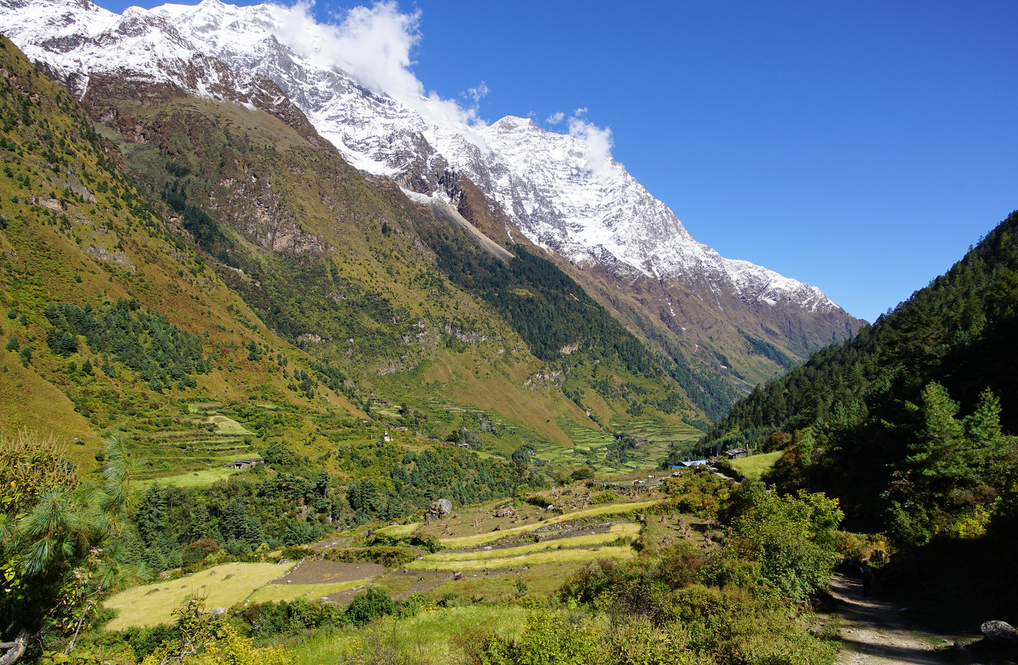Both the Annapurna and Manaslu circuits are well-known hiking routes in Nepal, which is part of the Himalayas. Trekking in these Himalayas delivers a unique experience on each trip. The Manaslu Circuit is a trek that encircles the eighth-highest mountain in the world, Manaslu, and boasts untouched nature and Tibetan culture whereas the Annapurna Circuit encircles the Annapurna Massif and contains some of the widest variety of terrain, and proven trail infrastructure in the world.
Both treks are popular among adventure enthusiasts, culture vultures, and nature lovers. Annapurna is king of accessibility, species diversity, and mountain communities and is easily achievable for casual trekkers. Manaslu is for experienced trekkers seeking a less trodden, more rugged experience in the wild.
Whether Manaslu or Annapurna is right for you or not is dependent on your tastes, fitness, and type of adventure. Whether you go for the classic trekking community vibe and social experience of Annapurna, or whether you choose to venture off the trail into the rawness of Manaslu the Himalayan views and cultural experiences will be unbeatable.https://mangabuddy.blog/
Overview of Each Trek
- Manaslu Circuit Trek
Manaslu Circuit Trek is located in western Nepal and is relatively untouched by many tourists due to its restricted status. You can experience a truly off-the-beaten-path during the 12-14 day long Manaslu trek. This trek offers incredible landscapes that you will certainly appreciate during your trek.
Manaslu Circuit trekking is famous for its Tibetan Buddhist culture and challenging pass at Larkya La Pass at 5,106 meters of elevation. However, in order to appreciate these features, you must obtain the Manaslu Conservation Area Permit (MCAP) and the Restricted Area Permit (RAP). With fewer tourists, this walk offers a special fusion of stunning landscapes and cultural immersion.
The trek route will take you through remote places, thick rhododendron forests, and a high alpine zone that offers spectacular views of Manaslu. The hike is a popular getaway for those seeking adventure and isolation because of its remoteness and ruggedness.
- Annapurna Circuit Trek
Located in central Nepal Annapurna Circuit Trek is the most popular and easiest trek in Nepal. This trek takes 15 to 20 days to complete and spans a number of ecosystems from lush subtropical jungle to dry high desert. The trek reaches its highest elevation of 5,416 meters at Thorong La Pass.
In order to do the trek, each trekker must have the Annapurna Conservation Area Permit (ACAP) as well as a Trekker’s Information Management System (TIMS) card to enter. This trek boasts a diverse cultural experience and a diverse geography because trekkers get an opportunity to visit many vibrant villages inhabited by Hindu and Tibetan Buddhist Communities.
Trekkers will experience stunning views of the mountains Annapurna, Dhaulagiri, and Manaslu, while also experiencing the Kali Gandaki Gorge and numerous hot springs. The Annapurna circuit provides trekkers with an established trail and teahouse accommodations, an ideal trail for any type of trekker.
Difficulty and Physical Demands
The Manaslu Circuit is regarded as more difficult due to its more isolated trails and amenities, steep climbs, and ample chance of altitude sickness because of the quick change in altitude, especially during the Larkya La Pass. The rugged, remote, and little support availability forces you into a good state of fit endurance and sufficient acclimatization.
On the other hand, the Annapurna Circuit has a gradual climb which allows more acclimatization along the way. The trek takes leaps up in altitude but has enough well-marked established trails, ample teahouses, and support services along the way to consume the logistics of the trek.
The Annapurna is not much physically easier than the Manaslu, but it is more accessible to more trekkers than the Manaslu; both trek remotes are out there and for you to keep pushing, endurance, and preparation.
Scenery and Cultural Experience
The Manaslu Circuit trek is in a more pristine state than the Annapurna Circuit. The Manaslu Circuit is less frequented and tourists are fewer, which allows trekkers to be more in tune with their surroundings. This area is heavily influenced by Tibetan Buddhist culture with rural traditions which can be a great spiritual experience.
The Annapurna Circuit provides a better range of scenery. Trekkers get to see everything from lush green valleys, Waterfalls, Rivers, high arid regions, and Rough Mountain passes.
Trekkers can engage with various ethnic groups including the Gurung, Thakali, and Manangi people. Interactions with these groups encourage unique experiences and insights into Nepal’s multi-cultural heritage. This diversity is a vivid and dynamic trekking experience.
Crowds and permits
The Manaslu Circuit trek attracts a smaller number of trekkers due to its restricted permit. At the same time, all trekkers must be accompanied by a licensed guide as of 2023, which enhances safety and encourages jobs for local people. There are several permits you must need including a Manaslu Restricted Area Permit, MCAP, and ACAP.
In contrast, the Annapurna Circuit is more popular and crowded, especially during the peak trekking seasons in spring and autumn. This area witnesses several trekkers each year that the Manaslu Circuit hasn’t seen in a decade.
While there is no requirement for a mandatory trekking guide on the Annapurna Circuit, it is always advisable to hire a guide for safety and cultural reflection. The only permit you need at this point is the Annapurna Conservation Area Permit (ACAP), and the TIMS card is no longer required here as of 2023.
Because of these restrictions and the opportunity for less confrontational hiking, the Manaslu Circuit is a great option for people wishing to be off the beaten path and working harder for a more intimate connection with the region’s vibrant Tibetan Buddhist culture.
The Annapurna Circuit’s flexible permit system and guide policies allow trekkers to maximize this experience. Regardless of who a person travels with on the trek, the Annapurna Circuit’s route provides more access to cultural experiences and local diversity that can never really be duplicated.
Costs and Logistics
The Manaslu Circuit Trek is typically higher priced since it requires a licensed guide. Permit costs alone can be between $75 to $100 and the overall cost with a guide, porter, food, and accommodations will typically be between $900 and $1,500 for a 10 – 15 day trek (longer is possible too). The accommodations along the Manaslu Circuit trek are basic and contain limited food and Wi-Fi options.
On the other hand, Annapurna Circuit is cheaper with lower permit costs of $40-$50, varying lodging, and food options within different budgets. There are better services such as roads, ATM’s or good internet connections, etc., and thus they are cheaper, easier, and reasonable. These are the reasons why it is better to hike the Annapurna.
Best Time to Visit
The best time for achieving both treks is in the spring and autumn. These seasons are marked by lovely weather, blue skies, and amazing Mountain View that lead to the best experience for trekking.
In spring, the blooming rhododendrons and the green valley make trekkers lost in the lush Himalayas while autumn’s crisp air and snow cover offer great sight line.
Manaslu Circuit Trek has a shorter trekking season than Annapurna Circuit Trek. During winter, trekking on Manaslu is exceptionally cold, and heavy snow can make traversing passes dangerous or even impossible.
In the monsoon season, it rains heavily and there is the risk of landslides. While the Annapurna Circuit has a more developed system of trails and infrastructure that could be flexible compared to Manaslu.
Which Trek is right for you?
The Manaslu Circuit is for those who prefer to trek in solitude, pristine, and unspoiled wilderness isolated from crowded trails. The Manaslu Circuit is more challenging than and not as straightforward as trekking on the Annapurna Circuit.
While the Annapurna Circuit can be crowded, the Manaslu Circuit routes offer a more distinct trek with steep ascents into Tibetan Buddhist culture. Expect to pay more because of the requirements of the Manaslu trek.
While the Annapurna Circuit has limited regulations, expect stricter regulations, additional fees, and hiring a guide with the additional costs of the Manaslu Circuit. The overall higher costs and requirements preserve the remote characteristic of the trek.
The Annapurna Circuit is for those who want a classic trek, well supported, and featuring diverse landscapes from lush valleys to arid highlands. There is still flexibility in the possibility of itineraries and tours since the Annapurna Circuit provides a variety of accommodations with history including guesthouses, lodges, and tea houses with southern and middle Himalayan culture and better infrastructure. This trek is for you if you enjoy meeting other trekkers and experiencing the variety of ethnic cultures along the trek route.
Conclusion
The Manaslu and Annapurna Circuits are both fantastic Himalayan trekking experiences but the differing factors of isolation, difficulty, and cultural exposure can make all the difference between the two.
The Manaslu trek offers greater isolation, more challenging terrain, and higher costs with stricter permit rules. While the Annapurna trek is family friendly with a more diverse trek to choose from with more budget-friendly options and infrastructure. Take time to consider your level of fitness, personal budget, and trekking style.
If you want personalized advice seek a reputable trekking company, which can help you find the trek that is best suited for you as an individual. Whether you are going for solitude or social trekking, both trekking routes offer amazing adventures you will not forget. Which trek can you see yourself on? What are your thoughts? Let us know in the comments below!




